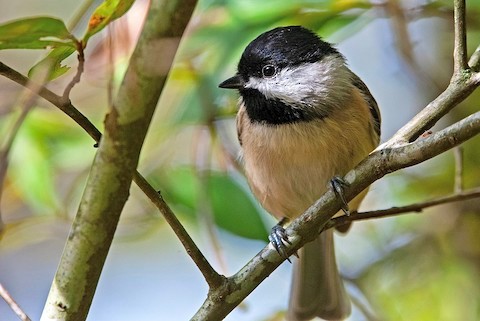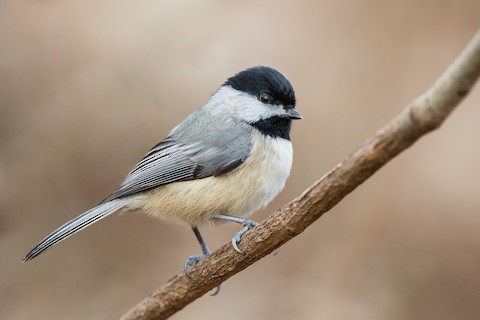Birdfinding.info ⇒ One of the most abundant and familiar songbirds of the eastern U.S., it is among the principal attendees of backyard bird feeders from the Ohio Valley and Mid-Atlantic states to central Texas and central Florida. For a more detailed view of its distribution, see Breeding Bird Survey Abundance Map in Notes, below.
Carolina Chickadee
Poecile carolinensis
The Carolinian Forest region of the eastern U.S.
Resident in all types of woodlands, including suburban and urban neighborhoods, from northern Indiana and Ohio, central Pennsylvania, and New Jersey south to the Gulf of Mexico, west to the Texas Panhandle and the Edwards Plateau, and south to the central Texas coast and central Florida (to Tampa Bay).
In the Appalachians from south-central Pennsylvania to western North Carolina, it generally breeds at lower elevations than the Black-capped Chickadee. The threshold elevation varies from approximately 1,000 m to 1,800 m (generally becoming higher southward).
Outside of the U.S., there is a single Canadian record: at Point Pelee, Ontario, May 12-13, 2013. It has been recorded along the Río Grande near Del Rio, Texas, but there appear to be no confirmed Mexican records (as of early 2022).
Identification
The common chickadee of the southeastern U.S. Unmistakable except in areas of potential overlap with the Black-capped Chickadee. Carolina has more uniformly gray wings, but this difference is subtle.
Instantly recognized as a chickadee by its bold head pattern: a jet-black crown and throat with contrasting white cheeks.

Carolina Chickadee. (Eagle Creek Park, Indianapolis, Indiana; January 11, 2020.) © Peter Finley

Carolina Chickadee. (Newark, Ohio; February 14, 2021.) © Brad Imhoff
The upperparts are mostly medium-gray. The underparts can be either whitish or grayish or washed with buff or cinnamon.

Carolina Chickadee, showing typically grayish underparts. (Eagle Creek Park, Indianapolis, Indiana; January 11, 2020.) © Peter Finley

Carolina Chickadee, showing a pronounced cinnamon wash on the underparts. (Lake Conestee Nature Preserve, Greenville, South Carolina; October 25, 2019.) © Andrew Simon
Voice. Best known for its signature chick-a-dee call, which is higher-pitched and faster than the Black-capped Chickadee’s equivalent call: The typical song is a clear, four-note whistle (high-low, high-low):Sometimes gives a three-note variant:A five-note variant:And a six-note variant:Also various chip notes and jumbled calls, including rapid gurgles:
Notes
Polytypic species consisting of four recognized subspecies.
See below for a comparison of the Carolina Chickadee with the Black-capped Chickadee.
Cf. Black-capped Chickadee. The Black-capped and Carolina Chickadees occur together, or near one another, in a band that extends from southern Kansas across central Missouri and Illinois and northern Indiana and Ohio to central New Jersey—and much more widely in the Appalachians from central Pennsylvania south to western North Carolina. In summer, the two populations remain mostly separate, with Black-capped occupying higher elevations of the Appalachians, although they are known to interbreed occasionally. In winter, Black-capped invades Carolina’s territory, at least locally.
They can be extremely similar and both vary enough internally that some individuals are ambiguous. With hybrids known to occur at least occasionally, some are simply not identifiable. For the ones that are merely similar, the most consistent differences are their voices and the color patterns on their wings.

Black-capped Chickadee, showing its diagnostic white inner panel on the greater wing coverts. (Blackpool, Les Jardins-de-Napierville, Quebec; December 19, 2018.) © Pierre Bannon

Carolina Chickadee, showing its uniformly gray greater wing coverts. (Cincinnati, Ohio; December 23, 2021.) © Don Danko
Their typical songs differ. Black-capped gives a clear two-note whistle (high-low), whereas Carolina typically gives a four-note whistle (high-low, high-low). Each species gives its own version of the chick-a-dee call, but Black-capped’s is lower-pitched and has a slower cadence: 3 to 4 notes per second. Carolina’s call is about 5 to 7 notes per second. Vocalizations alone are sometimes misleading, however, as individuals in the contact zone have sometimes been observed adopting the calls of the other species.
Visually, Carolina averages grayer overall, especially on the wings. Carolina’s wings are nearly uniform gray, whereas Black-capped’s wings have pronounced, often uneven, white markings on the flight feathers and wing coverts. In most cases, Black-capped shows a contrast within the greater wing coverts—where the outer portion is relatively dark or medium-gray and the inner portion is white or whitish.
References
Alderfer, J., and J.L. Dunn. 2014. National Geographic Complete Birds of North America (Second Edition). National Geographic Society, Washington, D.C.
BirdLife International. 2016. Poecile carolinensis. The IUCN Red List of Threatened Species 2016: e.T22711708A94306849. https://dx.doi.org/10.2305/IUCN.UK.2016-3.RLTS.T22711708A94306849.en. (Accessed February 3, 2022.)
eBird. 2022. eBird: An online database of bird distribution and abundance. Cornell Lab of Ornithology, Ithaca, N.Y. http://www.ebird.org. (Accessed February 3, 2022.)
Harrap, S., and D. Quinn. 1995. Chickadees, Tits, Nuthatches & Treecreepers. Princeton University Press.
Sibley, D.A. 2014. The Sibley Guide to Birds (Second Edition). Alfred A. Knopf. New York.
Xeno-Canto. 2022. Black-capped Chickadee – Poecile atricapillus. https://xeno-canto.org/species/Poecile-atricapillus. (Accessed February 3, 2022.)
Xeno-Canto. 2022. Carolina Chickadee – Poecile carolinensis. https://xeno-canto.org/species/Poecile-carolinensis. (Accessed February 3, 2022.)


